Update & two weeks in Provence
We have been very busy with our French classes and excursions in Provence and so have not been able to post in a while. Also, we did not have an Internet connection in our apartment in Aix, and had to rely on the computers at school, which were in heavy demand. We are now back from our time in Provence and our brief trip to the States to participate in the graduation of my nephew, Chris, from Brown University (magna cum laude and Phi Beta Kappa). Also spent a couple of days with Madeline’s mom in Oberlin. She is doing quite well, all things considered, although only speaking a word now and again. We have prepared this post on Provence; in the near future we will have additional posts on our apartment here in Lannion and other matters of potential interest.
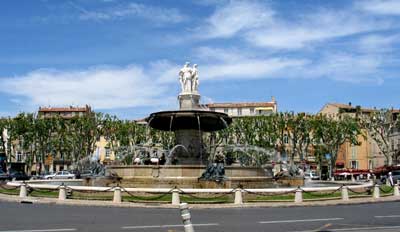
We thoroughly enjoyed our two weeks in Provence (Aix's Fountaine de la Rotunde above), which has yet to be completely spoiled by the influx of tourists and rich Parisians who have been attracted to the region by Peter Mayle’s books and the TGV trains that can whisk you from Paris to Marseilles in less than four hours. TGV stands for trains de grande vitesse, or very fast trains. (The French love to apply initials to everything.) Our last day in Aix was as close to perfect as a day can be. We went on a ramble in a regional park with views of Mount Saint-Victoire, a favorite subject for Cézanne. The sky was the cerulean blue that painters love, the sun was shining, and there was a touch of the mistral wind to keep the heat from being oppressive. Provence doesn’t get all that much rain and the soil is rocky. Vegetation is sparse, mostly pines and cypresses, tenacious shrubs like a variety of holly with tiny leaves, wild flowers, and wild herbs like rosemary and thyme.
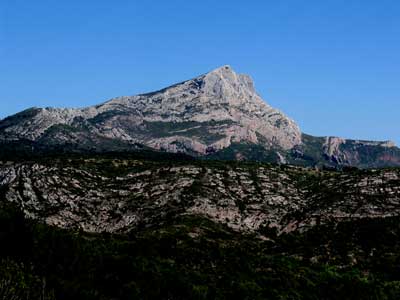
Mount Sainte-Victoire is not all that tall as mountains go, about 1,800 feet, but it is more a ridge that a mountain and so dominates the countryside. The southern face is without vegetation; its pale limestone expanse stands out sharply against the sky. Surrounding the mountain are valleys and ravines with steep slopes. Some of the rivers have been dammed, and the reservoirs are a blue-green that seems almost unreal. We walked for a little more than an hour with our local guide and two students from school, a Dutch woman and a German one.
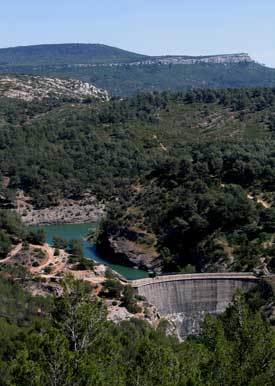
Upon our return, we dined in the garden of our studio apartment in Aix. Our apartment was attached to the home of Madame Desandre at the end of a dead-end street about 10 minutes by foot from IS, the language school where we had two weeks of classes. Madame loves to garden, and we picked a pound of her cherries, now at their peak in Provence, for our dessert. Madame also has apple, apricot, fig, and almond trees in her yard. When she made dinner for us Wednesday, she seasoned the vegetables with parsley from her garden. One of the joys of our year in France will be to devour each fruit and vegetable as it comes into season. We have already had exquisite strawberries, white and green asparagus, and cherries. Out-of-season fruit from Africa and South America is available in France, but the French don’t eat much of it, preferring perfectly fresh fruit (and vegetables) that were not picked before ripening. Our dinner was accompanied by a rosé, a wine that is produced in huge quantities in Provence, accounting for about 80 percent of regional production. Much of it is made from Syrah grapes, although some Grenache and Mourvedre are also used. There are a few good red wines there, too, notably those of Bandol and Bellet. Not m
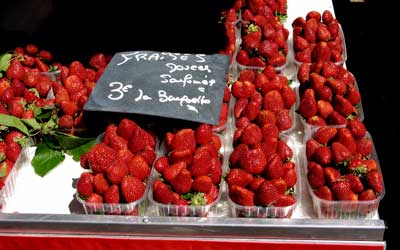 uch white is made.
uch white is made. 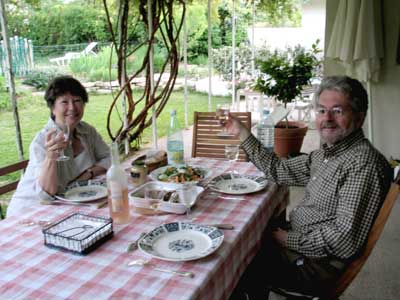
Aix is a charming city of 180,000 people, notable for its universities and more than thirty fountains in the old city. It has, alas, become more and more tourist-oriented of late, especially in this year of Cézanne. Cézanne died in Aix one hundred years ago, and the Aixois are compensating for their neglect of him while he was alive by cashing in big time during his centennial year. Like many of the cities in Provence (Marseilles, Arles, Nîmes), Aix was part of the Roman Empire, although no ruins survive in Aix.
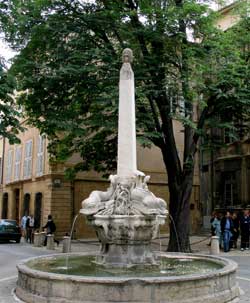
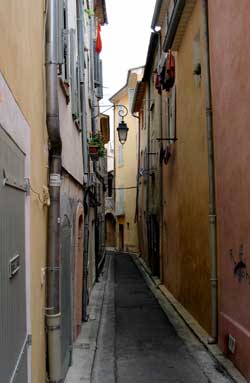
The city’s period of greatest prosperity was the late 17th and most of the 18th century. At this time, successful merchants and minor nobility built elegant townhouses in Aix (hôtels particuliers), and many of these survive. Their facades are crafted from a local stone with a pleasing pale ochre tint to it. The style is neoclassical (see facade below), with an occasional over-the-top baroque touch like exaggerated scrolls flanking a pediment or pilasters that take the form of larger-than-life-size male or female figures. The streets of the old city are narrow and not arranged in any discernable pattern, so we were frequently consulting our map. Many crossroads have fountains that vary from a single pipe in a basin to the lavish 19th-century fountain of the Rotonde (first picture above).
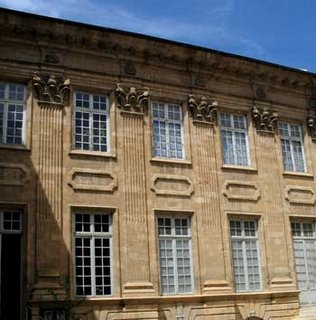
We liked our school a lot. The teachers are excellent, very dedicated and encouraging, which they need to be, considering the very wide range of nationalities and levels of ability they deal with. The school attracts students from all over, mostly from other European nations, but also Americans, Canadians, Japanese, Chinese, and the odd South American or African. We had a placement exam on the first day and Madeline landed in the top section while I fell two levels below. At school, I had English in common with the Australians, Canadians, and Swedes (almost all of whom learn English in school), but with the Dutch, Japanese, and Germans, I pretty much had to use my French. Madeline had a piquant experience the night we had a lesson in traditional Provencal cuisine. Ten of us were seated at a long table, and conversations were going on in German, Swedish, French and English—all languages that Madeline understands.
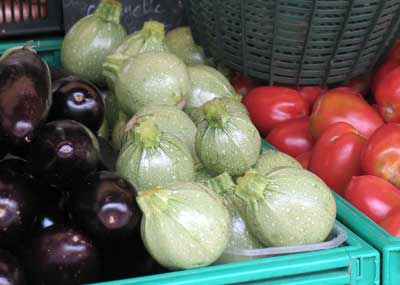
We had class for three hours each morning, and then a different activity every afternoon or evening. These included a lecture on and tasting of Provencal wine; an afternoon in Marseilles; a visit to Cézanne’s last studio; a guided tour of old Aix; and the hike and cooking lesson previously alluded to. Provencal cuisine is not haute cuisine, but country cuisine, based on locally available ingredients like olives, onions, garlic, eggplant, zucchini (we'd never seen spherical zucchini!) , bell peppers, various fruits, and nuts like the almond and pine nut. The most typical meat is lamb. People in Marseilles and other coastal towns ate fish and shellfish, but traditionally the inland areas of Provence didn’t get much fish, at least in the period before refrigerated trucks. The habitual Provencal cheese is chevre, made from goats’ milk. At our cooking lesson/feast, we had thin slices of eggplant stuffed with chevre, deboned leg of lamb stuffed with an olive/onion/garlic/herb mix, and a lemon tart.
Before arriving in Aix, we spent two days in Nîmes, and we also had a day-long excursion arranged by the school to Avignon and a small town known as Les Baux de Provence. We will try to post some commentary and photos on those places in the future.
I will close with some Aixois experiences that confirm for me that jazz is truly a universal language. Upon our arrival in Aix, as Madame was driving us down the Cours Mirabeau, a boulevard of cafés and tony shops, a trio was playing “All the Things You Are.” Later we learned that Madame’s son is a jazz drummer, and played with Gil Evans on his last European tour. Madame herself is musical, singing in a jazz-oriented chorus whose style and repertory are reminiscent of Manhattan Transfer. Madame played a CD of her group, which included very nice arrangements (done by a group member) and quite creditable versions of “A-Tisket-A-Tasket” and “Sing, Sing, Sing,” complete with some scat singing. The accents were a bit weird, but the music was great! (Below a "mouse" of lamb and grilled eggplant that we enjoyed in Nimes.)
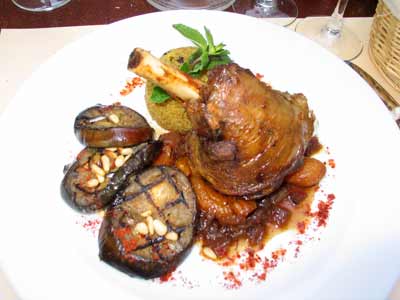

1 Comments:
Dear Bob & Madeline,
I just viewed your June 3 blog entry & enjoyed your wonderful photos and commentary. You sure are having perfect weather - bright blue skies and vivid blue-green water, like I saw in British Columbia. The food sounds marvelous!
I'm sorry to relate that I am still very ill- horrible cough & full-blown head & chest congestion. My legs are very weak and I'm very short of breath with little exertion. I called the Dr. last week, but can't see her until 3PM June 6th, tomorrow.
I've cancelled yoga & computer classes and my volunteer job at MBMC. I have a low-grade fever and am sleeping a great deal - rare for me! I hope I can get well by June 20, when I fly to San Diego. Also hope you two didn't catch my germs.
Love, Mom
Post a Comment
<< Home